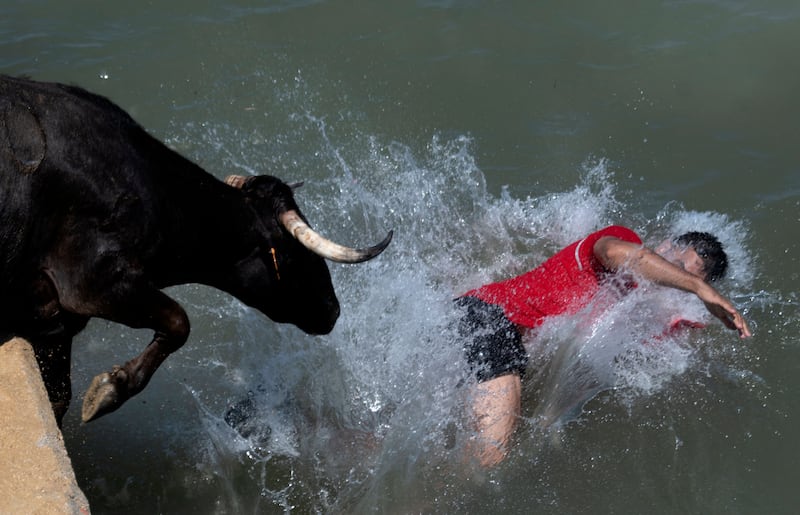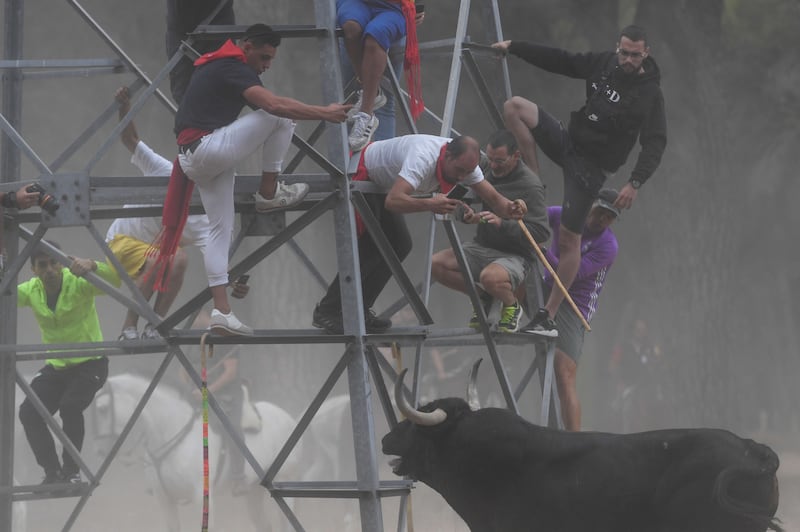This week the town of Tordesillas, on the plains of central Spain, held its annual Toro de la Vega festival, in which a bull is chased around nearby fields by local people in a tradition that can be traced back centuries. Until recently, lances were used to stab the bull repeatedly until it collapsed and died, but such weapons have been banned since 2016 and instead the chase now ends with the bull being led away for slaughter.
Toro de la Vega marks the end of the season of summer festivities across Spain in which bulls and cows are baited by participants. But while the use of animals at these events remains a divisive issue, it is the wellbeing of the humans who take part which has come under particular scrutiny recently due to an alarming death toll.
Seven people have died in the Valencia region alone this year after being gored while taking part in local festivities, prompting El País newspaper to label this a “black summer” for such traditions. Three others died elsewhere around the country in similar festivities.
“Is a fiesta in which people die really a fiesta?” asked Aitana Mas, vice-president of the leftist government of the Valencia region.
“What would have happened this summer if those seven people had died in wildfires?” she said.
Valencia is home to the Bous al carrer tradition in which bulls run free through the streets and squares of towns, mingling with spectators. There are several variations, which can also be seen in Catalonia, involving participants, usually young men, running close to the animal or even prodding it while trying to avoid being gored. In another form of the tradition, the Bous a la mar, bulls are lured by spectators into leaping from a dock into the sea.

The death toll this year in Valencia is the equal highest on record. The victims included a 73-year-old woman and an 18-year-old man, both of whom were gored at separate events, and a 64-year-old French tourist who was stamped on by a bull. There were also about 300 people injured, including a 15-year-old boy who was gored in the leg.
Germán Zaragoza, the president of the association which supervises Valencia’s Bous al carrer festivities, said that this year there were more events held than before the pandemic, totalling about 7,000, and 25 per cent more people taking part. That has been mooted as a possible reason for the numbers of fatalities and injuries.
As the death toll rose this summer, the local authorities in the town of Tavernes de la Valldigna cancelled their own festivities, which were due to be held this week. The mayor of the town, Sergi González of the left-wing Compromís party, said that the decision was based on the fact that “society evolves” and that the risk linked to the fiesta was too high.
While other towns have discussed the need for greater safety measures, some have mooted the possibility of holding referendums on the continuation of their festivities. In the town of Massamagrell, the Socialist mayor, Paco Gómez, has proposed that the town hall should pay for insurance cover for future festivities, thus taking responsibility for any injuries or deaths.

All of this has opened up a fierce debate about the Bous al carrer, meaning that familiar battle lines have been drawn on an issue which has long had a political tinge.
The right in Spain has traditionally presented itself as a defender of bullfighting and related festivities. While the centre-left Socialist Party has tended to be more lukewarm on the issue, parties further to its left, such as Compromís, have actively campaigned to ban these activities at a local level on animal rights grounds.
The latest controversy caused the head of the conservative Popular Party (PP) in the Valencian province of Castellón, Salvador Aguilella, to accuse the left of using “policies that try to impose on us signs of identity” and he insisted that the Bous al carrer are “a festivity that forms part of our traditions.”
The political right frequently accuses the left of using the campaign against bullfighting and animal-based town fiestas as an electoral weapon. One bullfighting commentator, writing on the Toros de Lidia news website, said that “the death of these unfortunate people is helping the commies who govern in many of the towns in our region ... as they try to ban this tradition.” The writer then pointed out that more than 200 people drowned this summer in the sea or in swimming pools, asking: “Do we close the beaches to prevent such accidents?”
Meanwhile, the concerns over the safety of people who take part in the fiestas has revived the animal rights debate. A petition for the Bous al carrer to be banned in the Valencian town of Jávea has gathered more than 36,000 signatures in recent days, while warning that those who take part in such festivities “are often drunk or on drugs” and describing the events as “torture dressed up as tradition”.























